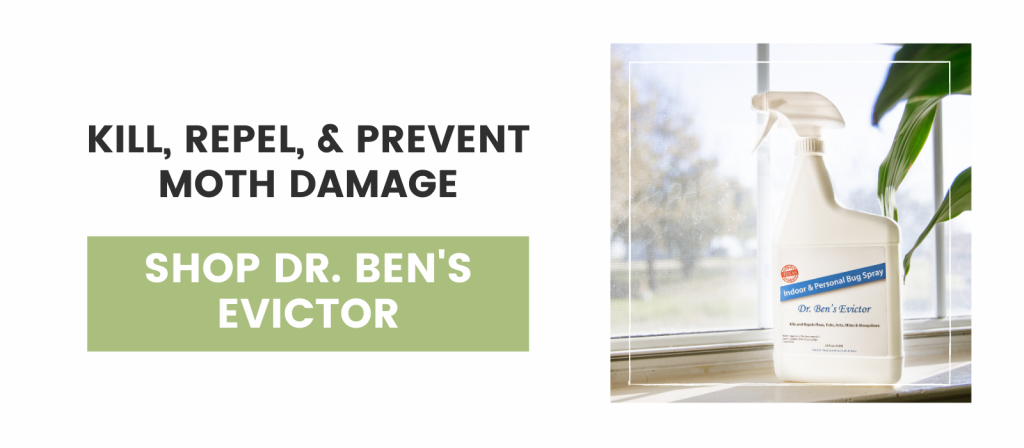
How to Kill & Prevent Moths Naturally
Have a moth problem or worried you might? Want to learn how to prevent moths from entering your home and damaging your clothing, bedding, and other fabrics? This article is for you.
In only 3–5 minutes of reading, you’ll learn how to safely, easily, and quickly get rid of and deter moths without having to use those super toxic mothballs or expensive pest control services. (Did you know naphthalene and paradichlorobenzene, the active ingredients in mothballs, have been linked to cancer, neurological damage, and infant death?)
If you have moths, there’s no time delay—the longer you wait, the more difficult, expensive, and time-consuming the problem will become—so let’s get to it.
How to Stop Moth Damage
After discovering you have moths, the first thing you want to do is put a stop to the damage they’re causing.
The first step is to get rid of any moth caterpillars, eggs, and adult moths that are hiding out in storage areas, clothing, rugs, and other fabrics. It might sound like a lot, but the process is pretty simple and doesn’t take all that long. Washing and drying any potentially infested items will work, as will dry cleaning or placing them in your freezer for 3 days.
If you’re dealing with pantry moths (aka Indianmeal moths) instead of traditional clothes moths, you’ll need to toss out all dry goods in your pantry and surrounding areas that are not in airtight containers, including dog food, nut and seed packages. Immediately discard these items in a tightly sealed trash bag in an outdoor trash bin to avoid additional pantry moth issues.
To clear out common breeding sites like closets, pantries, and other storage areas, empty out the space, vacuum every surface, nook and cranny, and deep clean the entire areas including the walls and flooring with an all-purpose cleaner or soap and hot water (a 1:1 solution of vinegar and water is also an effective option). Take your time and be thorough, moths can hide and lay eggs in the tiniest of cracks and corners. For the contents of your vacuum and all damaged items you plan to throw out, seal them in a trash can and promptly place it in an outside trash can to avoid re-infestation.
How to Kill & Repel Moths
Now that moths are no longer chewing away at your valuables, it’s time to finally get them out of your home and keep them away.
To repel moths, we’re going to use the same approach that makes cedar chests and cedar closets so effective at deterring moths and other damaging pests. First, fill a stocking or another similar breathable bag with 100% natural Cedar Granules and hang it somewhere in your closet, pantry, or other storage areas where you’re worried about moths. Replace the granules every 6–8 weeks. Next, mist the flooring, walls, baseboards, racks and shelves of these areas with non-toxic Ben’s Evictor monthly or more often as needed for active moth issues.
To kill moths, we’re also going to use plant-based Ben’s Evictor, which unlike traditional chemical-based insecticides, will not endanger your family, pets, or your home’s air quality. All you need to do is directly spray any moths, moth caterpillars or eggs you encounter while tackling your moth problem. For spaces you suspect of moth activity, lightly spray the walls, baseboards, flooring, ceiling, and all cracks and crevices to kill any eggs, caterpillars, or adults you might have missed.
How to Prevent Moths
Prevention is always simpler and cheaper than having to get rid of an active moth problem. The below tips will help you avoid additional moth issues in the future.
- The cleaner and more organized your home, the less likely you are to experience bugs, including moths. Periodically dusting, vacuuming, and deep cleaning flooring, walls, closets, rugs, baseboards, and furniture is essential.
- Vintage or secondhand furniture, rugs, clothing, and even your groceries can introduce moths into your home. Always check these items for signs of moths—such as webbing, holes, eggs, or caterpillars—before purchasing them. If you see anything suspicious after you bought something, simply treat the item with Ben’s Evictor before bringing it inside (not including groceries, of course).
- Always wash and dry fabrics and clothing before hanging them in your closet or storing them away. Moths are attracted to the smell of sweat, hair and skin oils, and food and drink spills.
- Limiting unnecessary humidity and maintaining adequate ventilation, especially in closets, pantries and storage spaces, is crucial to moth and other bug prevention.
- Always use airtight hard plastic containers when storing clothing or fabrics for extended periods of time. Moths can easily gain access to poorly sealed packages and chew through thin plastics, cardboard, and baggies.
- Always store dry goods and pet foods in airtight hard plastic or glass containers to limit pantry moth populations.
- Use cedarwood’s natural moth-repelling qualities by hanging a stocking full of 100% natural Cedar Granules in your closets, storage areas, and pantries. This can do wonders for preventing or reducing moth problems before they can become more severe and widespread. Replace the granules every 6–8 weeks.
Need Help Solving Your Roach Problem?
Whether you need step-by-step advice or aren’t sure which product is right for you, we’re here to help. Give us a call or email us for free expert advice. Look forward to chatting with you soon!
Stay connected with us on Instagram.
PHONE: 210-599-0449
EMAIL: Bobamarine@cedaroilindustries.com


